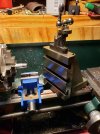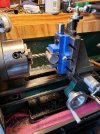Ian
Notorious member
For $150 total, shipped from India with a double-acting vise included, I couldn't resist. Together with a clamping set and bars, blocks, etc this is 100% better than no mill at all and doesn't take up much space in the shop. The table is 3x5", way better than the 2x3" tool post milling attachments and Z-bar mount


Last edited:

